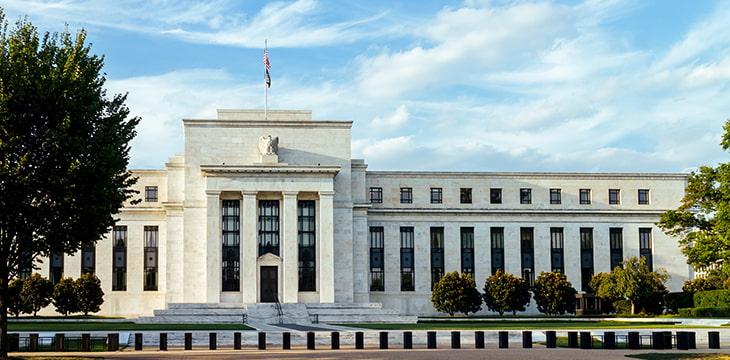|
Getting your Trinity Audio player ready...
|
The long-awaited central bank digital currency (CBDC) report from the United States Federal Reserve has been published.
When it comes to a CBDC, the United States is proceeding with caution, explicitly stating that they are neutral on the subject and don’t favor a particular outcome regarding the creation of a CBDC.
However, the Fed acknowledges the benefits that a CBDC can introduce to banking and payment settlement, as well as the obstacles that would need to be overcome before CBDC implementation becomes a reality.
Here are the key takeaways from the Fed’s “Money and Payments: The U.S. Dollar in the Age of Digital Transformation” report.
The Federal Reserve recognizes that innovation in the banking and payment settlement space periodically takes place. There have been several advances in these markets that were possible because of new technology that enabled innovation. The Fed believes that blockchain technology and digital currency may be one of these innovations that can improve the banking and payment settlement world, so the Fed has been exploring the technology, the benefits it introduces, and the drawbacks that come with it.
How a CBDC can improve the American banking and payments systems
The Fed knows that the banking and payments system has room for improvement. Its report stated: “7 million—or over 5 percent of U.S. households—remain unbanked. [And] nearly 20 percent more have bank accounts, but still rely on more costly financial services such as money orders, check-cashing services, and payday loans.”
The report notes that cross-border payments often come with high transaction fees as well as slow payment settlement times due to timezone differences.
“As of the second quarter of 2021, the average cost of sending a remittance from the United States to other countries was 5.41 percent of the notional value of the transaction. These high costs have a significant impact on households that make remittance transactions. High costs for cross-border payments also affect smaller businesses that make infrequent global payments to suppliers. Reducing these costs could benefit economic growth, enhance global commerce, improve international remittances, and reduce inequality,” it stated.
Given the features native to most digital currencies, such as nearly instantaneous payment settlement time, low transaction fees that are often less than a penny, the low barrier to entry given that most blockchain networks are public, and the ability to program money, the Fed sees digital currency as a monetary tool that could reduce the amount of unbanked or underbanked people in America while lowering the costs associated with remittances and cross border payments.
“A U.S. CBDC would offer the general public broad access to digital money that is free from credit risk and liquidity risk. As such, it could provide a safe foundation for private-sector innovations to meet current and future needs and demands for payment services,” said the Fed report.
“A CBDC might generate new capabilities to meet the evolving speed and efficiency requirements of the digital economy. As noted above, for example, a CBDC could potentially be programmed to deliver payments at certain times. Additionally, a CBDC could potentially be used to carry out micropayments—financial transactions that usually occur online and involve very small sums of money—which traditional payment systems are not necessarily designed to facilitate.”
The obstacles
Implementing a CBDC would create a new set of problems for both the central bank and the United States residents. The creation of a CBDC would mean that a new form of money would be entering the economy, which would alter the structure of the banking and payment settlement system. Experts at blockchain research firm nChain expect that countries of all sizes and economic development are now realizing the benefits of blockchain technology and setting up national digital currencies. Simit Naik, nChain’s Director of Commercial & Strategy, said: “Central Banks have more clarity around their requirements and the advantages in using a public blockchain to deliver a CBDC that most closely resembles cash.”
For the Federal Reserve, the primary concerns are that digital assets could make bank runs more severe, could reduce the availability of credit in the financial markets, and that it has the potential to disrupt the current concentration of economic power.
“Because central bank money is the safest form of money, a widely accessible CBDC would be particularly attractive to risk-averse users, especially during times of stress in the financial system. The ability to quickly convert other forms of money—including deposits at commercial banks—into CBDC could make runs on financial firms more likely or more severe. Traditional measures such as prudential supervision, government deposit insurance, and access to central bank liquidity may be insufficient to stave off large outflows of commercial bank deposits into CBDC in the event of financial panic,” it said.
“Banks currently rely (in large part) on deposits to fund their loans. A widely available CBDC would serve as a close—or, in the case of an interest-bearing CBDC, near-perfect—substitute for commercial bank money. This substitution effect could reduce the aggregate amount of deposits in the banking system, which could in turn increase bank funding expenses, and reduce credit availability or raise credit costs for households and businesses.”
How to reduce the risks associated with CBDC
The Fed references a paper by the President’s Working Group (PWG), which raises the same concerns around a CBDC that the Fed has. The PWG report said that the solution would be for Congress and legislators to create regulatory frameworks that would mitigate the risks associated with the implementation of a CBDC; however, the report recognizes that there are currently gaps and uncertainty regarding who has authority to regulate CBDCs.
The Fed is looking for expert insight
Overall, the report indicates that the Federal Reserve has blockchain and digital currency on its radar and that it will continue to research these technologies until there is enough evidence that it is beneficial and that they should be implemented into the banking and payments system, or that they come with too much risk and should not be implemented.
“The Federal Reserve will only take further steps toward developing a CBDC if research points to benefits for households, businesses, and the economy overall that exceed the downside risks, and indicates that CBDC is superior to alternative methods. Furthermore, the Federal Reserve would only pursue a CBDC in the context of broad public and cross-governmental support,” the report revealed.
To catalyze this initiative and better understand CBDCs, The Fed is looking for insight from experts. It is accepting comments on their specified set of questions until May 20, 2022.
To learn more about central bank digital currencies and some of the design decisions that need to be considered when creating and launching it, read nChain’s CBDC playbook.
Watch: U.S. Congressman Bill Foster on Bitcoin Association’s Blockchain Policy Matters

 12-22-2025
12-22-2025 




